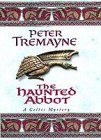|
Another Review at
MyShelf.Com
|
||||||||||||
|
The
Haunted Abbot Peter
Tremayne (aka Peter Berresford Ellis) is an authority on the ancient
Celts and in his wonderfully unusual Sister Fidelma stories this
deep well of knowledge comes bubbling forth. This is the twelfth
book in this popular series and the stories show no sign of flagging
yet; every book has something new and exciting to enjoy. This time
it is midwinter, close to Christmas (or Yule for the many pagans)
and Fidelma and Eadulf are traveling through a blizzard in a "mad"
farmer's cart to reach Aldred's Abbey. This is home to Brother Botulf,
a childhood friend of Eadulf who has to see him about something
urgent. But once inside the abbey, everything starts to go wrong.
Botulf has just been murdered, Abbot Cild is set against the Celtic
Church and his former wife haunts the place. With Fidelma ill with
a chill, Eadulf doesn't know where to turn, and soon the pair find
themselves prisoners in this lonely abbey in the dead of winter,
surrounded by dangerous and outlaw-haunted marshes. |
|||||||||||
